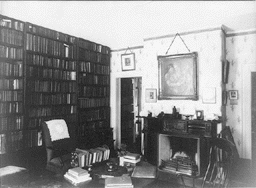Ralph
Waldo Emerson
Ralph
Waldo Emerson, known as the "Sage of Concord," was born in
Boston on May 25, 1803. His
youth was marked by poverty and sickness. Emerson graduated from Harvard
College in 1821 and returned to study at Harvard Divinity School. In
1829, Emerson became a Unitarian minister of the Second Church in Boston.
After becoming dissatisfied with his profession, he resigned from the
position and traveled throughout Europe. When Emerson returned to the
United States in 1833, he began to write and lecture.
In
1836, Emerson wrote Concord Hymn. It is a poem about the Revolutionary
War battle fought on April 19,1775 between British and American soldiers.
The battle took place in the Massachusetts towns of Lexington and Concord.
During that same year, he also published his first book, Nature.

Click
to See Larger Image
Emerson's Study 1888
Courtesy of The Library of Congress
In
the book, Henry Hikes to Fitchburg, "Henry's friend moved
the bookcases in Mr. Emerson's study." This photograph of Emerson's
study was taken in 1888. You will notice in the book that the bookcases
have handles on the ends. The handles allowed the bookcases to be removed
quickly from the house in case there was a fire.
Thoreau
was a frequent visitor in the Emerson home. As he carried firewood to
the house, he would blow a whistle as a signal for the children to open
the door. There was a woodbox just inside the house. As soon as he dropped
the wood into the box, the children would hug his knees. They also loved
his magic and playful nature.
"This
youthful, cheery figure was a familiar one in our house, and when he,
like the 'Pied Piper of Hamelin,' sounded his note in the hall, the
children must needs come and hug his knees, and he struggled with them,
nothing loath, to the fireplace, sat down and told stories, sometimes
of the strange adventures of his childhood, or more often of squirrels,
muskrats, hawks, he had seen that day, the Monitor-and-Merrimac duel
of mud-turtles in the river, or the great Homeric battle of the red
and black ants. Then he would make our pencils and knives disappear,
and redeem them presently from our ears and noses; and last, would bring
down the heavy copper warming-pan from the oblivion of the garret and
unweariedly shake it over the blaze till reverberations arose within,
and then opening it, let a white-blossoming explosion of popcorn fall
over the little people on the rug. Later, this magician appeared often
in house or garden and always to charm." - Edward Waldo Emerson
from Henry Thoreau as Remembered by a Young Friend.
Emerson
died on April 27, 1882 and is buried on Authors' Ridge in Sleepy Hollow
Cemetery located in Concord.

